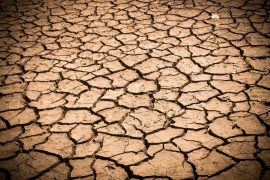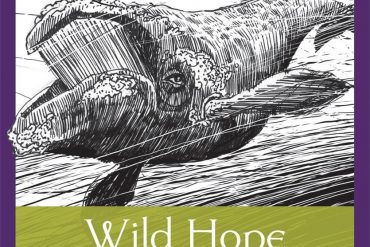In the beginning … was the story. Before the word was the Word, before there were buildings, before there were high priests, before there were commandments, before there was writing itself, there was story. The rocks in the landscape, the creatures that dwelt nearby, the lights puncturing the vaulted dome of sky, the paths amidst them—these were the mnemonics of story, offering a living cartography of relationship.
“In the beginning” is a story in itself. It tells of a time-before-once-upon-a-time. It sets an origin point, a moment to be followed by other moments, gathered up in strands, woven together in a patterned whole, into a story-basket, carried under the crook of an arm, nestled on the hip, slung across the back, the better to collect other threads—the other fragments of story—along the way. For the story is the container and tool, the ancient and modern technology of meaning-making.
Between religion and nature is the story. Perhaps it’s easier nowadays—500 years removed from the printing press—to forget that stories are woven from natural elements. Texts have codified, canonized, and gilded black-and-white abstractions with power. We are expert exegetes, deconstructing and gaming with words, turning the text on itself in recombinatory gymnastics. Too often, the authority of the word replaces the experience of the world.
The Tension between Word and World
I’ve experienced this tension—between word and world—in my own life, and my seminary education increased this friction rather than alleviating it. I came to Princeton Theological Seminary as an earnest young man. I had a religious story I felt confident in. Learning about how other cultures, and various peoples throughout history, understood the human relation to the sacred certainly complicated the story I inherited. These empathic gestures of imagination bent the strands of my life outward, fraying and unweaving portions of my tidy story-basket.
But even then, I sensed that there were other stories that were missing, tamped down and tucked away, in plain sight but seemingly unworthy of comment. From an early age, my religious experiences were entangled with my meanderings in the natural world. As I got older, when I wanted to feel divine presence, I was just as likely to go for a hike as I was to go to a church. I was hopeful that seminary would give me some way to explore those connections more fully, a way to expand the command to “love thy neighbor” to all neighbors, human and nonhuman. Yet a wide swath of the world was unaccounted for in the lectures I heard in the classroom, in the aspirations I saw among my fellow students, in the conversations that occurred in the cafeteria. The focus of seminary seemed all-too-human; and prioritizing ethical relationships with the natural world wasn’t on the radar.
Of course, there was a lot of talk, and a lot of reading and writing, about God, who ostensibly had some concern for nonhuman creations. But most often the gods I heard about at seminary were, among others, the God of Luther, who was an answer to an existential crisis; the God of Calvin, who was a supreme ruler, plucking at the strings of grace; and the God of Barth, who could be systematically defended. I did occasionally hear talk of “the creation,” but it was on the margins, an affirmation of God’s glory rather than a moral responsibility or an end in itself.
I looked for refuge in the mystic misfits, like Meister Eckhart and Thomas Merton, and I searched the hagiographies of sainted rebels, like Francis of Assisi, who seemed to have fewer qualms about celebrating and embracing a more-than-human community as part of the glorious whole. I found a couple of classes that fed my hunger, and when the classes weren’t available, I invented them with the help of willing professors and independent studies. Traditions of creation care could be found in a seminary education. But, in my experience, they weren’t a core part of the curriculum; you’d have to be prepared to do some academic peregrinating.
Why didn’t a seminary education (at a “liberal” institution, no less) include a more explicit focus on caring for the more-than-human? I have a lot of hunches. But instead of spilling ink on specific historical and cultural factors that have suppressed looking to the “book of Nature” for guidance, I’d like to highlight a contrasting pair of settings.
Two Settings
The first setting is a campus building that will be familiar to many seminarians: the chapel. As might be expected on an Ivy League campus, the columned chapel exterior is elegant while avoiding decorative ostentation. As might be expected of a Protestant chapel (particularly one whose style is informed by the Reformed tradition), the interior is sparsely appointed. With the exception of a lone, unbodied cross, the chapel lacks iconography. The word (hearing it, reading it, saying it) reigns here—orderly rows of wooden pews face the altar, which like the desks in adjacent classrooms are positioned toward a lectern. Congregants come to “hear the word of the Lord” delivered (often by a titled dignitary) from this central pulpit. Hymnbooks, the Book of Order, the Bible—these are the tools to expound upon and through which to ingest the written lessons of God.
The second setting comes from my “field education” experience in the summer of 1999. Itchy to get away from school, I chose to do my field service at Glacier National Park in Montana, as part of a program in A Christian Ministry in the National Parks. I worked part-time in the park at a “regular” job and was responsible for leading weekly worship services for tourists and employees. On Sundays, these services were held inside Glacier Park Lodge, overlooking a dramatic sweep of the northern Rocky Mountains; on Wednesdays, my team traveled to various campgrounds and led simple services around a campfire ring.
The settings of these services, where hiking boots and sandals rather than polished loafers kept time with the music, and where warbled voices drifted upward with woodsmoke, always seemed more in keeping with stories about the god of the Hebrew Bible. It didn’t happen a whole lot, but when mortals were graced with a divine appearance in biblical texts, Yahweh smoldered in a pillar of cloud, combusted whole shrubs, and spoke out of the tornadic air of a whirlwind. This was a god of the wilds—one that could smite with brimstone as easily as rain manna.
It’s in one’s best interest to keep humble beneath a sky like that. And the landscape of Glacier National Park is nothing if not humbling. The smallness it inspires among park visitors isn’t simply on account of the grizzlies. This is not a manicured campus but a landscape carved of ancient forces, with massive glacial cirques, knife-edged arêtes, and lakes so aquamarine you may wonder if you could cup your hands and pull gemstones from the water. I’m certain this glacier-hewn landscape factored into the services, creating a subtle melody underneath the songs we sang and the words we spoke, aiding us in thinking beyond our own self-involved concerns toward a larger community of life.
I share this set of contrasting images with no intent to disparage the sacred qualities of either place. I spent many an early morning with my forehead pressed against the back of a pew in the seminary chapel, grateful for the peaceful solitude of the filtered half-light. To everything there is a season—a time to come in and reflect with fewer distractions, a time to go out and feel the bite of wind on a mountain saddle—and these two places offer different experiences to different seekers.
I do think, however, these places make apt metaphors of religious orientation. If I were to do a directional analysis, I might say that the chapel encourages an upward and especially inward orientation, while a setting like Glacier encourages lateral movement and an outward orientation. The emphasis falls on word in the former, on world in the latter. The places in which we expect to meet the sacred—the places in which we are told to speak softly, walk with care, respect the place and those within it—reveal a good deal about the dimensions of our moral relationships.
Interwoven: Stories, Religion, and Nature
Religion—its artifacts, its texts, its architecture, its adherents—tells a story. Our relationships to the natural world—as individuals, as communities, as cultures—are stories about how we are connected and disconnected, responsible and not responsible, and at home or temporary visitors. Religion provides narratives to make sense of the world, to direct attention to what seems important or worthy of concern, and to where and how humans fit within the larger sphere of beings with whom we share (or don’t share) this earthly realm.
After seminary, I got a PhD in religious studies. My focus turned from religion as belief to what religion does. To put it another way, I came to see the distinguishing features of religion less as propositional formulas (“I believe x, y, z…”) and more as relational orientations (i.e., ideals for how to interact and engage with the world). It also became clear to me that these relational orientations are conferred and reinforced by valued narratives. We are, all of us, whether bound to a particular religious tradition or not, walking stories.
Dissimilar from boxed-up books in the attic or those neatly filed on office shelves, our stories do not stay put. They spill out onto the landscape where they shape and constrain the life histories of other species. Our stories, to borrow a metaphor from nature writer Scott Russell Sanders, are “a form of stored energy, like the sunlight captured in a chunk of coal, but unlike coal, which disappears in the burning, stories retain their heat and light as long as there are minds capable of understanding them.” Though stories vary in their content and the linkages they create, “they all do this fundamental work of gathering and binding” [ref]A Conservationist Manifesto, 85. [/ref]
Religious stories, including cultural worldviews that function as sacred narratives, gather and bind—indeed, the word religion, from the Latin, religare means to re-bind, reconnect. These mythical narratives are conduits for world-making, creating order and coherence, gathering and binding particular ways of thinking and acting, and they may inspire some of our most deeply rooted and potent assumptions.
Relationships among story, religion, and nature matter. They are interwoven. Religion is a method of story-delivery about how we should relate. It would be a mistake to equate religious stories as products of the intellect, mind, imagination, or myth in distinction from the land, nonhuman creatures, the earth, or our places of inhabitation. Religious stories are “walking stories”; that is, they are enacted and, conversely, vulnerable to the shaping and reshaping powers of the landscape and the beings—human and nonhuman—who dwell in particular places. Religious narratives, if they are to remain relevant and adaptive, must be responsive to a living world.
A Personal Walking Story
When the declarations of maddened prophets and cuff-linked theologians pressed too insistently against the inside of my skull at seminary, I sometimes broke into a walk. I took to the backtrails behind the Princeton Battlefield State Park or to the dirt path that arrowed alongside the nearby canal. If I had walked far enough, I might have ended up in Trenton or New Brunswick—but I always circled back to campus.
On one such day a gentle rain was falling, the kind whose touch on exposed skin warms and soothes, the kind that beads on the ends of your hair in supple drupes. By the time I ambled back toward the dormitories, the tortured word-formulas of the classroom had been washed away by rainwater. I recall being lured toward a particular tree behind Hodge Hall—I wouldn’t have been able to name it then, my knowledge of natural history having been neglected in favor of Christian history. But not knowing how to categorize the tree may have served me well: in that moment, it was not “tree” or “crepe myrtle” or Lagerstroemia indica. It was, rather, a living individual, shimmering in rivulets of water, as I was. I pulled in close, eye to leaf, and my jaw fell slack as I watched glistening blobs of rainwater dance across mottled green. Surface tension held these droplets temporarily apart, while sky and gravity conspired to unite them, until these forces were too much to resist. The drops merged and streamed away like lightning strikes.
I don’t know how long my trance held. I walked on, some part of me feeling that, now full of wonder, I shouldn’t overstay. But I remember the impulse to throw my arms around the world—as if there were no enemies, only errors of perception.
Maybe this is what Julian of Norwich, that visionary fourteenth-century English anchorite, meant when she looked at a hazelnut and said, “What may this be?” and heard in response, “It is all that is made.” “I marveled how it might last,” she continues, “for I thought it might suddenly have fallen to nothing for littleness. And I was answered in my understanding: It lasts and ever shall, for God loves it. And so have all things their beginning by the love of God.”
The rain, the tree, the walk pried something wide open. I understood (at least for a fleeting moment) a simple but comprehensive affirmation—an ongoing call and response between earth’s elements, including my own body. And this knitted beauty, I knew, would not be discovered by consulting textbooks but by being present to what was always already there.
It seems no longer tenable to share Julian’s unwavering faith that, as with the hazelnut in her vision, all manner of things will be well. There are too many reminders of the harms that we visit upon our soils, waters, and air. But if there are glimmers of hope that things will be well—from hazelnuts to grizzly bears—then we’ll need stories that point the way and orient us on this shared common ground in which we live, move, and have our being.
Walk On
One piece of advice to seminarians: walk. Walk sideways through your studies; transgress property and academic lines when you can; bushwhack beyond the well-worn paths; learn the details of the near-at-hand. Walk. Naturalist-poet Gary Snyder advised, “The wild requires that we learn the terrain, nod to all the plants and animals and birds, ford the streams and cross the ridges, and tell a good story when we get back home” [ref]Practice of the Wild, 26. [/ref]
The stories we tell when we circle back home will forge a way forward. Walk on.
[separator type=”thin”]
Bibliography
Sources for those interested in the relationship between religion, story, and nature:
Plumwood, Val, Eye of the Crocodile. Canberra, ACT: Australian National University E Press, 2012.





